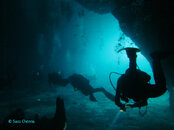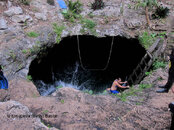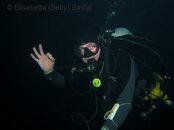Soakedlontra
Contributor
I will never forget Cenote Angelita...
Diving cenote Angelita was an experience unlike any other.
View attachment 113916

A fish is swimming above the cloud of hydrogen sulfide.
The layer of hydrogen sulfide that crowns cenote Angelita lay at a depth of 90 feet. During the descent I could not clear my ears so I had to hover 10 feet above it until I could equalize. After signalling the dive master that my ears were OK, he asked my buddy and I if we wanted to descend into the cloud. As soon as I signaled him that I was ready a strange feeling of awe and dread found its way into my brain. The excellent visibility rapidly deteriorated and became zero. I held my buddy's hand. We could not see the light of the dive master anymore. As far as we were concerned we could have been descending inside the atmosphere of an unborn planet. After several seconds the water cleared. I recognized dead leaves and tree branches that covered the sloping bottom. We looked around for few minutes with the cloud of hydrogen sulfide hovering above our heads, then it was time to begin our slow ascent to the surface of the cenote
.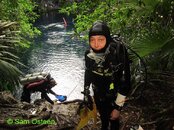
View attachment 113916

A fish is swimming above the cloud of hydrogen sulfide.
The layer of hydrogen sulfide that crowns cenote Angelita lay at a depth of 90 feet. During the descent I could not clear my ears so I had to hover 10 feet above it until I could equalize. After signalling the dive master that my ears were OK, he asked my buddy and I if we wanted to descend into the cloud. As soon as I signaled him that I was ready a strange feeling of awe and dread found its way into my brain. The excellent visibility rapidly deteriorated and became zero. I held my buddy's hand. We could not see the light of the dive master anymore. As far as we were concerned we could have been descending inside the atmosphere of an unborn planet. After several seconds the water cleared. I recognized dead leaves and tree branches that covered the sloping bottom. We looked around for few minutes with the cloud of hydrogen sulfide hovering above our heads, then it was time to begin our slow ascent to the surface of the cenote
.

Last edited:



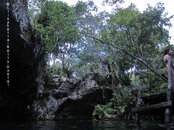
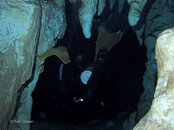
 . Well, the fact is that keeping a constant balanced trim and buoyancy throughout those dives was not that easy, especially judging distances between the variable ceiling and the various rock formations on both sides of my body. The cavern environment was so different from what I have experienced so far that it was hard to resist the hypnotic temptation to keep looking in all directions to admire its multifaceted beauty. The ceilings were studded not just with stalactites but 'mirrors' too (trapped air bubbles that reflected the light like mirrors), the walls kept changing their shapes and thickness, the light, especially in Gran Cenote, filtering through the ceiling cracks and holes created an enchanting play between reflections and shadows.
. Well, the fact is that keeping a constant balanced trim and buoyancy throughout those dives was not that easy, especially judging distances between the variable ceiling and the various rock formations on both sides of my body. The cavern environment was so different from what I have experienced so far that it was hard to resist the hypnotic temptation to keep looking in all directions to admire its multifaceted beauty. The ceilings were studded not just with stalactites but 'mirrors' too (trapped air bubbles that reflected the light like mirrors), the walls kept changing their shapes and thickness, the light, especially in Gran Cenote, filtering through the ceiling cracks and holes created an enchanting play between reflections and shadows. 